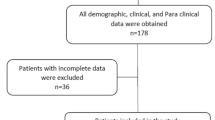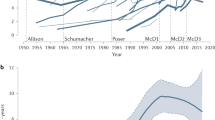Abstract
Ancient founder mutations in the Mediterranean fever gene, MEFV, are associated with familial Mediterranean fever, a recessive, episodic, inflammatory disease. Since these mutations are reported to express with above normal levels of acute phase reactants in healthy heterozygotes we postulated that the heterozygous phenotype could aggravate the clinical expression of ongoing autoimmune diseases. This study evaluated progression to disability in relapsing–remitting multiple sclerosis (RR-MS) patients of non-Ashkenazi and Ashkenazi origin carrying an MEFV mutation, particularly the detrimental M694V, using the expanded disability status scale (EDSS). In the non-Ashkenazi patients group (n=48), carriers (n=17) presented with a two-fold higher fraction which reached EDSS=3.0 and 6.0 compared to noncarriers (n=31) despite a comparable mean of MS duration. The median time to reach EDSS=3.0 was 2 years in the carriers vs 10 years in noncarriers (P=0.007); The median time to reach EDSS=6.0 was 6 years vs 23 years, respectively (P=0.003). M694V heterozygous patients reached both EDSS milestones earlier than other patients. Progression to disability was not enhanced in Ashkenazi RR-MS carriers (n=12, noncarriers n=59). In conclusion, non-Asheknazi MS patients carrying one mutated MEFV gene, particularly M694V, expressed rapid progression to disability. The expressed mutation may increase inflammatory damage inflicted by autoimmune responses.
This is a preview of subscription content, access via your institution
Access options
Subscribe to this journal
Receive 6 digital issues and online access to articles
$119.00 per year
only $19.83 per issue
Buy this article
- Purchase on Springer Link
- Instant access to full article PDF
Prices may be subject to local taxes which are calculated during checkout


Similar content being viewed by others
References
French consortium. A candidate gene for familial Mediterranean fever. Nature Genet 1997; 17: 25–31.
International FMF Consortium. Ancient missense mutations in a new member of the RoRet gene family are likely to cause familial Mediterranean fever (FMF). Cell 1997; 90: 797–807.
Touitou I . The spectrum of familial Mediterranean fever (FMF) mutations. Eur J Hum Genet 2001; 9: 473–483.
Dewalle M, Domingo C, Rozenbaum M et al. Genotype–phenotype correlation in Jewish patients suffering from familial Mediterranean fever. Eur J Hum Genet 1998; 6: 95–97.
Livneh A, Langevitz P, Shinar Y et al. MEFV mutation analysis in patients suffering from amyloidosis of familial Mediterranean fever. Amyloid. Int J Exp Clin Invest 1999; 6: 1–6.
Cazaneuve C, Sarkisian T, Pecheux C et al. MEFV-gene analysis in Armenian patients with familial Mediterranean fever: diagnostic value and unfavorable renal prognosis of the M694V homozygous genotype — genetic and therapeutic implications. Am J Hum Genet 1999; 65: 88–97.
Shinar Y, Livneh A, Langevitz P et al. Genotype–phenotype assessment of common genotypes among patients with familial Mediterranean fever. J Rheumatol 2000; 27:1703–1707.
Aksentijevich I, Torosyan Y, Samuels J et al. Mutation and haplotype studies of familial Mediterranean fever reveal new ancestral relationships and evidence for a high carrier frequency with reduced penetrance in the Ashkenazi Jewish population. Am J Hum Genet 1999; 64: 949–962.
Stoffman N, Magal N, Shohat T et al. Higher than expected carrier rates in the MEFV gene in various Jewish ethnic groups. Eur J Hum Genet 2000; 8: 307–310.
Kogan A, Shinar Y, Lidar M et al. Common MEFV mutations among Jewish ethnic groups in Israel: high frequency of carrier and phenotype III states and absence of a perceptible biological advantage for the carrier state. Am J Med Genet 2001; 102: 272–276.
Gershoni-Baruch R, Shinawi M, Leah K, Badernah K, Brik R . Familial Mediterranean fever: prevalence, penetrance and genetic drift. Eur J Hum Genet 2001; 9: 634–637.
Tidow N, Chen X, Muller C et al. Hematopoietic-specific expression of MEFV, the gene mutated in familial Mediterranean fever, and subcellular localization of its corresponding protein, pyrin. Blood 2000; 15: 1451–1455.
Centola M, Wood G, Frucht DM et al. The gene for familial Mediterranean fever, MEFV is expressed in early leukocyte development and is regulated in response to inflammatory mediators. Blood 2000; 15: 3223–3231.
Cattan D, Notarnicola C, Molinari N, Touitou I . Inflammatory bowel disease in non-Ashkenazi Jews with familial Mediterranean fever. Lancet 2000; 355: 378–379.
Livneh A, Aksentijevich I, Langevitz P et al. A single mutated MEFV allele in Israeli patients suffering from familial Mediterranean fever and Behςet's disease (FMF-BD). Eur J Hum Genet 2001; 9: 191–196.
Ozdogan H, Arisoy N, Kasapcapur O et al. Vasculitis in familial Mediterranean fever. J Rheumatol 1997; 24: 323–327.
Booth DR, Lachmann HJ, Gilmore JD et al. Prevalence and significance of the familial Mediterranean fever gene encoding pyrin Q148. QJM 1001; 94: 527–531.
Tunca M, Kirkali G, Soyturk M, Akar S, Pepys MB, Hawkins P . Acute phase response and evolution of familial Mediterranean fever. Lancet 1999; 353: 1415.
Poland DC, Drenth JP, Rabinovitz E et al. Specific glycosylation of alpha(1)-acid glycoprotein characterizes patients with familial Mediterranean fever and obligatory carriers of MEFV. Ann Rheum Dis 2001; 60: 777–780.
Shinar Y, Pras E, Seiv-Ner I et al. Analysis of allelic association between D6S461 marker and multiple sclerosis in Asheknazi and Iraqi Jewish patients. J Mol Neurosci 1998; 11: 265–269.
Chapman J, Vinokurov S, Achiron A et al. APOE genotype is a major predictor of long-term progression of disability in MS. Neurology 2001; 56: 312–316.
Pras E, Aksentijevich I, Shinar Y et al. Lack of evidence for an association between two genetic polymorphisms in the tumor necrosis factor receptor 1 gene and multiple sclerosis in Ashkenazi Jews. Eur J Neurol 2001; 46:153–155.
Kurtzke JF . Rating neurologic impairment in multiple sclerosis: an Expanded Disability Status Scale (EDSS). Neurology 1983; 33: 1444–1452.
Noseworthy JH, Luchinetti C, Rodrigez M, Weinshenker BG . Multiple sclerosis. N Engl J Med 2000; 343: 938–952.
Myhr KM, Raknes G, Nyland H, Vadeler C . Immunoglobulin G Fc-receptor (FcgammaR) IIA and IIIB poly-morphisms related to disability in MS. Neurology 1999; 52: 1771–1776.
Sellebjerg F, Madsen HO, Jensen J, Garred P . CCR5 delta 32, matrix metaloproteinase-9 and disease activity in multiple sclerosis. J Neuroimmunol 2000; 102: 98–106.
Topcuoglu MA, Karabudak R . Familial Mediterranean fever and multiple sclerosis. J Neurol 1997; 244: 510–514.
Lossos A, Eliashiv S, Ben-Chetrit E, Reches A . Optic neuritis associated with Familial Mediterranean fever (FMF). J Clin Neuro-opthamol 1993; 13: 141–143.
Kwon OJ, Karni A, Israel S et al. HLA class II susceptibility to multiple sclerosis among Ashkenazi and non-Ashkenazi Jews. Arch Neurol 1999; 56: 555–560.
Maayan S, Zhang L, Shinar E et al. Evidence for recent selection of the CCR5-delta 32 deletion from differences in its frequency between Ashkenazi and Sephardi Jews. Genes Immun 2000; 1: 358–361.
Weatherby SJ, Thomson W, Peper L et al. HLA DRB1 and disease outcome in multiple sclerosis. J Neurol 2001; 248: 304–310.
Xu L, Badolato R, Murphy WJ et al. A novel biologic function of serum amyloid A. Induction of T lymphocyte migration and adhesion. J Immunol. 1995; 155: 1184–1190.
Badolato R, Wang JM, Murphy WJ et al. Serum amyloid A is a chemoaltractant: induction of migration adhesion, and tissue infiltration of monocytes and polymorphonuclear leukocytes. J Exp Med 1994; 180: 203–209.
Schreiber BM, Veverbrants M, Fine RE et al. Apolipoprotein serum amyloid (SAA) down regulates smooth muscle cell lipid biosynthesis. Biochem J 1999; 344: 7–14.
Trapp BD, Peterson J, Ransohoff RM, Rudick R, Mork S, Bo L . Axonal transection in lesions of multiple sclerosis. N Engl J Med 1998; 238: 278–285.
Poser CM, Paty PW, Scheinberg L, et al. New diagnostic criteria for multiple sclerosis: guidelines and research protocols. Ann Neurol 1983; 13: 227–231.
Acknowledgements
The authors are grateful to Dr Art McMorris for helpful discussions and to Dr Dan Kastner, Dr Irun Cohen, and Dr Mordechai Pras for reviewing the manuscript. Supported by Grant No. 6279 from the Israeli Ministry of Science.
Author information
Authors and Affiliations
Corresponding author
Rights and permissions
About this article
Cite this article
Shinar, Y., Livneh, A., Villa, Y. et al. Common mutations in the familial Mediterranean fever gene associate with rapid progression to disability in non-Ashkenazi Jewish multiple sclerosis patients. Genes Immun 4, 197–203 (2003). https://doi.org/10.1038/sj.gene.6363967
Received:
Revised:
Accepted:
Published:
Issue Date:
DOI: https://doi.org/10.1038/sj.gene.6363967
This article is cited by
-
Familial coexistence of demyelinating diseases and familial Mediterranean fever
Rheumatology International (2022)
-
Periodic fever syndromes: beyond the single gene paradigm
Pediatric Rheumatology (2019)
-
T helper 17 polarization in familial Mediterranean fever
Genes & Immunity (2013)
-
MEFV gene variations in patients with systemic lupus erythematosus
Modern Rheumatology (2013)
-
Association of Missense Mutations of Mediterranean Fever (MEFV) Gene with Multiple Sclerosis in Turkish Population
Journal of Molecular Neuroscience (2013)



